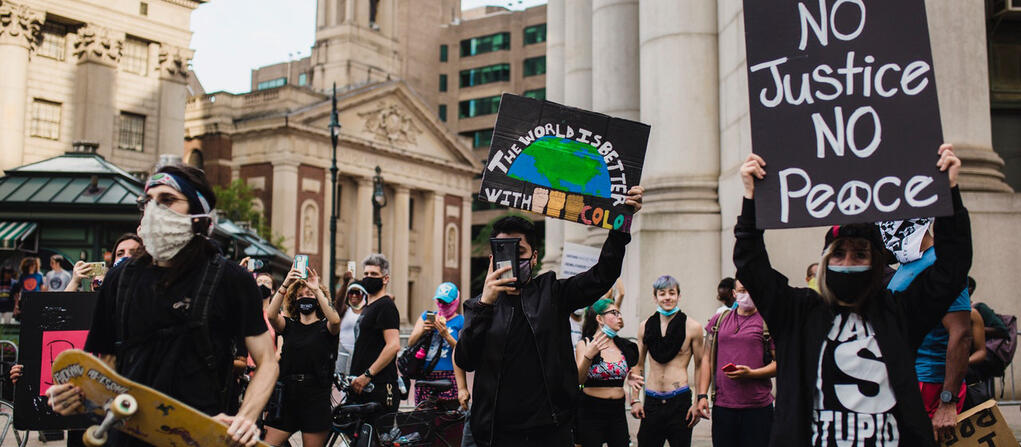
November 13, 2020
We can all become advocates and allies in this fight; here are some ways to make “social and environmental justice” more than just a catchphrase.
As advocates around the country continue to fight for equal rights for all citizens of the United States, the breadth of social inequities encapsulated by “systemic racism” continues to be illuminated. One such inequity recently brought to the forefront of conversations is environmental racism—racist, discriminatory policies at every level of government that intentionally and disproportionately burden low-income and/or communities of color with environmental hazards.
To combat these policies, the term ‘Environmental Justice’ emerged in the 1950s from a study that traced the federal government’s bulk placement of hazardous waste sites within African American communities—in effect demonstrating environmental racism. Since then, light has been shed on countless other discriminatory policies and planning, for example, the fact that both governing bodies and private corporations benefit financially from polluting in these vulnerable communities; that policies meant to sustain residents, such as the Safe Drinking Water Act, are underenforced in vulnerable communities; or that vulnerable communities have the least amount of public amenities such as parks or healthy grocery stores.
However, environmental justice is not just about highlighting these discrepancies. True environmental justice refers to redistributing decision-making power back to vulnerable communities that are systemically impacted by environmental racism.
Practice Self-Education
The first step in empowering and amplifying voices within vulnerable communities is self-education on the links between structural racism and the disproportionate environmental hazards found in underprivileged communities. In addition to learning about the inequities themselves, do some research on the local and federal policies that are designed to perpetuate those differences in the first place. Additionally, it is important to realize that even within major environmental groups and non-profits, the leadership tends to be middle class and white. Be careful not to blindly assume that these organizations, policymakers, and leaders are advancing environmental justice for all. Read up on their policies and initiatives to get an understanding of whether or not the concerns, priorities, and voices of underprivileged citizens are on the agenda. A quick Google search of “environmental social justice” or “environmental racism” is an easy start to your self-education, on either current inequitable environmental hazards or policymaking.
Elevate the Voices of Impacted Communities
Once you’ve educated yourself, get to know the social justice advocates in your community, and support them however you can. This support can take on several forms. If it is feasible for you, you can donate directly to organizations advocating for environmental justice or lend your help as a volunteer. As the Black Lives Matter advocacy this summer demonstrated, online amplification of voices and sharing of resources on whatever platform available to you can also be helpful. Within the Yale community, continued amplification of student outreach through either Dwight Hall or the Afro-American, Asian American, Latino, and Native American Cultural Centers is important, too. No matter what avenue you decide to pursue, the priority is making sure these environmental issues don’t get lost to the noise.
Hold Your Representatives Accountable
Beyond amplifying the voices of environmental justice activists, it is important to examine the role that individual citizens can play in dismantling structural racism, namely at the local level. Stay informed about the local environmental issues in your community. When issues come up concerning permitting and land use plans, policy design and enforcement, and grant awards advocate for these issues to be prioritized and the decisions concerning them to be made transparent. In short, hold your community and your representatives accountable for their environmental votes! Let’s all do our part to change the narrative that environmental considerations in our communities is cumbersome; the lasting impact of early intentionality is well worth our time.
Use the Power of Boycott
Holding your community and public officials accountable while not being intentional about where you spend your dollars is counterintuitive. Before you shop, investigate the environmental practices of corporations. While many companies have become increasingly transparent about their practices, deliberate environmental harm in vulnerable communities for economic gain is sadly commonplace. Instead of solely relying on big companies, consider investing your dollar in your local economy, e.g. shopping locally for groceries or buying directly from small or minority-owned businesses. You will probably discover some gems—whether it be your new favorite farmers market or local jeweler—in the process!
As demonstrated above, policy and environmental impact go hand in hand. Through illuminating and dismantling this fatal causality, we can help recover impacted communities from the legacies of environmental racism. In the process, our allyship will reach new heights of intentionality; our understood framework of social justice will be that much more comprehensive.